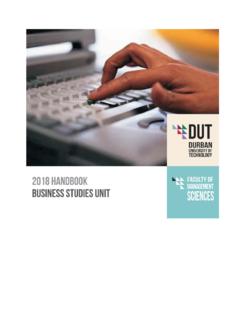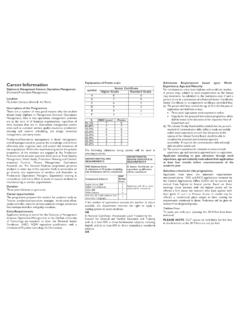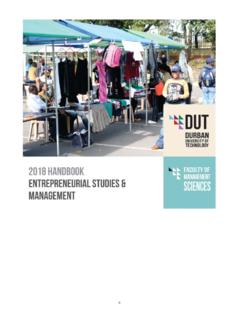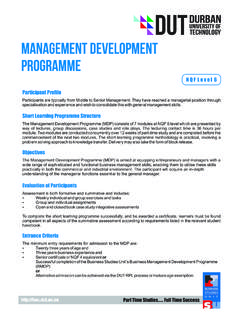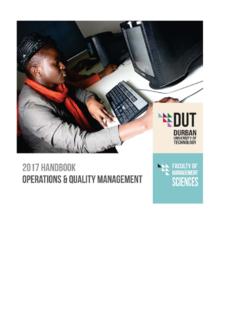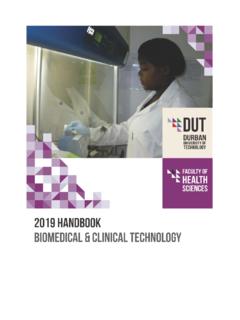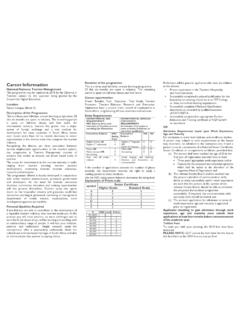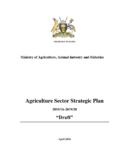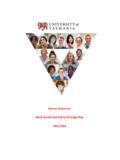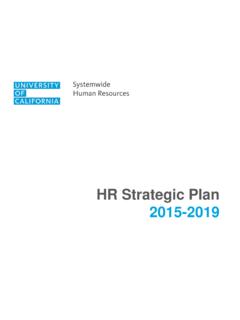Transcription of DUT STRATEGIC PLAN 2015 - 2019
1 DUT STRATEGIC PLAN2015 - 2019 Towards Relevance, Responsiveness and Resiliencestrategic plan 2015 - 2019 1 BUILDING A SUSTAINABLE UN IVERSITYBUILDING RESEARCH AN D IN NOVATION FOR DEVELOPM ENTBUILDING SUSTAINABLE STUDENT COM MUN ITIES OF LIVING AN D LEARN INGC onceptualising the STRATEGIC PlanThe design concept in this booklet (on the cover and elsewhere) is made up of the two strands of DUT s DNA, namely Student-centredness and Engagement. These strands could also be described as the two threads which make up the fabric of the University.
2 Connecting these strands are four STRATEGIC Focus Areas, each of which has its own motif that is carried four STRATEGIC Focus Areas encapsulate the core functions of teaching-learning and research, and are interwoven with, or bridge, the quintessential strands of Student-centredness and Engagement. These are further given effect by six drivers (which are defined later). The STRATEGIC plan is thus made up of two strands, four STRATEGIC Focus Areas, six A LEARN ING ORGAN ISATION STRATEGIC plan 2015 - 2019 I 2 Towards relevance, responsiveness and heads into its ninth year as a University.
3 While the institution has a rich history of more than one hundred years as a place of vocational and higher education it is the fact that DUT is now a University that makes this STRATEGIC planning process a defining milestone. Universities everywhere in the world are both intensely local and intensely global and they are buffeted by conditions in both contexts. These conditions are in a state of rapid change due partly to the increasingly interwoven relationship between research and knowledge systems, industrial innovation and production, the cataclysmic upheavals in the world s financial systems, and the political contexts within which the institution resides.
4 As South Africa heads into a third decade of popular democracy, there are also vast changes taking place in global geopolitics which alters the way in which societies (and hence universities within them) relate to each other. It is, therefore, imperative for the continued wellbeing and relevance of any higher education institution that there is ongoing engagement on its STRATEGIC orientation and its external and internal are social institutions embedded in the contexts in which they find themselves and as such they have multiple purposes.
5 Of these three are primary. Firstly, they perform high level teaching and learning and thereby contribute to the development of a flexible, deep labour market that matches the needs of a complex economy. Secondly, they perform research and thereby contribute to the generation of new knowledge. Some of this will be blue-sky research performed for the purpose of contributing to humanity s understanding of the universe in all its manifestations. But universities also contribute to knowledge production that is STRATEGIC and applied in nature, contributing to the global competitiveness of South Africa s industry or that helps South Africa solve its reconstruction and sociopolitical challenges.
6 Thirdly, universities contribute to the building of critical, participatory citizens who are both national and global in scope, who strengthen this still nascent democracy while ensuring they are also effective as individuals in an increasingly globalised, increasingly connected world. Engagement with society in all its manifestations is a key terrain for each of these contributions. So universities are driven by the local context in which they find themselves and by the forces of globalisation.
7 Holding interesting, intimate conversations across the staff spectrum is at the heart of any STRATEGIC planning process so that there are opportunities for building alignment within the institution. These should extend to external audiences as well. So, the purposes of a higher education institution can be stated as:u building ethical and engaged citizens for a multilayered, complex democracy, and contributing to imagining and shaping a new nation;u broadening and deepening the intellectual culture of our society.
8 While the institution has a rich history of more than one hundred years as a place of vocational and higher education it is the fact that DUT is now a University that makes this STRATEGIC planning process a defining framework for the STRATEGIC PlanTo remain a viable, sustainable institution it is critical to anticipate the opportunities, challenges and potential crises to the education producing the human resource and knowledge needs of a developing South Africa and its complex economy; andu being bridges to the global community.
9 Operating within the South African higher education (HE) landscape, DUT s context is one of transformation, reconstruction and development. The University is informed by various national policies, plans and strategies, including the Higher Education Act (No. 101 of 1997); the National Development plan ; recommendations of the National Planning Commission; the White Paper for Post-School Education and Training in South Africa and the Department of Higher Education and Training (DHET) 2014 2019 Enrolment plan .
10 The National plan for Higher Education (February 2001) identifies a number of key STRATEGIC goals for the country s higher education system, including educating for economic and social development through educational relevance, achieving equity through improving student access and success and sustaining and promoting DUT moves towards realising its identity as a university of technology, it is also confronted with the conditions buffeting all universities operating within the local and global higher education context.
